Insect Pests
Insects can devastate a crop of fruit in an unsprayed orchard. Unfortunately, there are no varieties with resistance to insects, but pears and peaches generally bear fruit with less damage in unsprayed orchards. Where a greater degree of protection from insect pests is desired, a combination of a few well-timed insecticide applications is an option. Always follow the label instructions for mixing rates and for safety precautions.
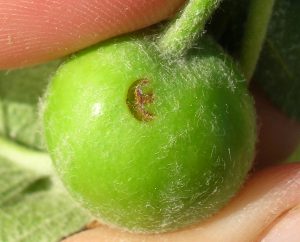
Plum curculio is a major insect pest of apple, plum, apricot and cherry, and a minor pest of pear and peach. Plum curculios overwinter under leaf litter at the edges of woodlots. They emerge in May and slowly move into orchards where they mate. After bloom until mid-July, adult female curculios lay eggs in fruit causing a characteristic crescent-shaped scar. Adult plum curculios will also feed on young fruit causing a tiny hollowed out cavity. The eggs hatch into larvae and feed inside the fruit and seed cavity, causing infested fruit to drop in early summer. Plum curculio larvae move from fallen fruit into soil, where they pupate and emerge as adults from late July into September. These next generation adult curculios feed on apples before finding overwintering sites. Late summer fruit feeding damage appears as irregular shaped holes that do not have time to heal before harvest. Feeding holes are often on the bottom end of the apple.
To prevent damage by plum curculios, an insecticide spray should be made shortly after petals fall from the blossoms or at the first sign of damage. For a high degree of control, a second application can be made about ten days later. If cool weather occurs, a third application provides a high level of control.
To protect bees, always wait until bloom is completely over to apply any insecticide. Products containing carbaryl (Sevin™) or phosmet (Imidan) are effective against plum curculio. Organic products such as pyrethrin are quickly degraded and will require reapplication at three- to seven-day intervals for effective control. Azadirachtin and other neem products have little or no effectiveness for controlling plum curculio.
Surround™ is a clay-based repellent that is also certified for organic use. In order to be effective, Surround™ coverage on fruit should be thorough beginning shortly after petals fall and re-applied weekly to maintain a white coating on the fruit and foliage until early July. Surround™ protection is designed to repel plum curculio until the egg-laying period is over.
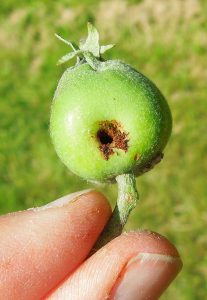
European apple sawfly is less prevalent that plum curculio in most years, but their seasons for damaging fruit overlaps. The adults lay eggs on the base of the apple flowers during bloom. The eggs hatch into larvae that initially feed on the surface of the fruit. This initial feeding creates a winding scar on the surface of the apple. A high degree of control requires an insecticide application soon after the petals fall from the tree. Delay of two or three days provides less control of damage, but later sprays will help prevent movement of larvae into a second or third fruit. Starting at about two weeks after petals fall, larvae that were not killed with a petal fall spray will begin moving from the first infested apple to a nearby apple. The sawfly creates tunnels into these apples, leaving a hole in the side. These fruit will soon drop off the tree. Insecticides and repellents that are applied for plum curculio also prevent damage by sawfly.
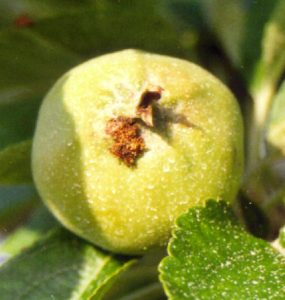
codling moth.
Codling moth can cause considerable damage in unsprayed orchards and is a primary pest of apple, and to a lesser degree of pear. The larvae damage fruit when they tunnel into apples and pears and feed on the seeds. An entry hole with sawdust-like excrement (“frass”) may be visible at the blossom end or on the side of the fruit. The damage to the fruit resembles the damage caused by European apple sawfly, but occurs later in July and into the fall.
Codling moths overwinter in the orchard as larvae. Following pupation, they emerge as adults in May and June when they mate and lay eggs in summer. Their offspring pupate in July and emerge as adult moths in August.
Where insecticide sprays with carbaryl or phosmet have been used to prevent plum curculio damage, there is much less chance of severe problems with codling moth. If pyrethrin or Surround™ were the only materials used against plum curculio, then additional treatments targeted against codling moth will be beneficial. Organic options include Surround™ coverage maintained through mid July; or two to three applications at seven- to ten-day intervals of Bt (Bacillus thuringiensis), azadirachtin, or Entrust™ from mid June into July.
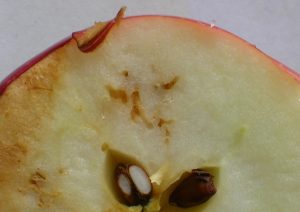
tunnels in the flesh of the apple.
The apple maggot larvae feed on the flesh of the fruit leaving a brown trail inside the apple in late summer. They overwinter as pupae in the soil and emerge in late June and July. Approximately ten days after emergence, the females begin to lay eggs in apples. They favor apples and plums.
Eggs and larvae are protected from insecticides and repellents since they are inside the apple. When insecticides are used to prevent damage, they should be applied just before egg laying occurs. Insecticide applications, starting in mid-July, with a renewal application in late July or early August, and a final application in mid August, are usually adequate to prevent apple maggot infestation. The final application may be omitted for earliest ripening varieties, and the first application maybe omitted for the latest ripening varieties. Insecticides should not be applied right before harvest. Esfenvalerate cannot be used within 21 days of harvest. Carbaryl (Sevin™), tree fruit spray and phosmet (Imidan) cannot be applied in the week before harvest.
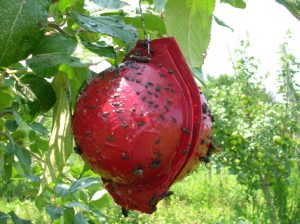
Red spheres the size of a large apple and covered with the sticky substance, Tangletrap™, can be used to trap adult flies. At least one trap for every 100 apples is needed to adequately prevent infestation. Use one trap on a dwarf tree or four traps on a semidwarf tree. Place traps in the orchard the first week of July. Traps should be completely covered with Tangletrap™ and hung from a branch in the outer part of the tree, surrounded by fruit, but not hidden by leaves.
The repellent Surround™ can be used in conjunction with traps or on its own for apple maggot. However, Surround applied to fruit in August may still be on the fruit at harvest and should be washed off before consuming the apple.
Different aphid species commonly occur on fruit trees, but are usually insignificant or only aesthetically damaging. Aphid populations are usually reduced by their natural enemies later in the growing season, so insecticide sprays are not warranted. One exception to this is for very young trees where a heavy aphid population can stunt growth. There are many fruit tree spray products to control aphids if needed. However, on established trees, spray application is typically not needed.
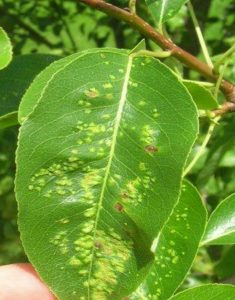
blister mites.
Pearleaf blister mites feed on leaves and cause red spots in springtime, usually along the midvein. A few weeks later, mites enter the blisters and lay eggs. These spots eventually turn brown or black in summer. Feeding on young fruitlets will cause depressed areas with russetting on the fruit surface. Blister mites overwinter beneath bud scales, becoming active at budbreak and causing leaf damage in the early stages of spring growth. The damage they cause is minor in most cases and not likely to affect the tree. Where damage is severe, a dormant oil spray can be applied according to the label instructions just after the buds swell in the delayed dormant period and horticultural oil after leaf growth begins. Blister mites are not likely to cause leaf damage in summer.
Pear slug is an uncommon and sporadic pest of pear trees. They eat the upper surface of pear leaves, but avoid the veins. Damaged foliage has a lacy or skeletonized appearance. They do most of their feeding in summer and are usually gone from the tree by the time the damage is spotted. In some cases, they cause substantial loss of foliage. Where damage is mild, it is of no consequence to the tree.
Japanese beetles feed on the foliage of fruit trees and prefer plum and cherry leaves to other types of fruit trees. The level of damage is most often insignificant, so the use of insecticides is not of value.
Earwigs feed on peach, nectarine and apricot fruit as they ripen in summer. Earwigs also feed on nectarines soon after bloom causing a large scar on the surface of the fruit at harvest. They have an elongated, dark brown or reddish brown body with pincers at the end.
As fruit ripen, they move from the ground cover into trees. Removing shoots that are in contact with ground cover will inhibit their movement into trees.
Monitor their presence in the orchard by placing a rolled up newspaper in the orchard several weeks before fruit begin to ripen. This should be examined for earwigs once a week. As they begin to move into the tree, carbaryl insecticide can be applied to the trunk. The efficacy of organic insecticides for control of earwigs has not been tested.
Trunk borers are insect larvae that feed on the bark and wood inside the trunk. Trees less than ten-years-old, and trees with a trunk diameter less than four inches are particularly vulnerable. Many young and dwarf fruit trees in home plantings are killed by borers. White spiral plastic trunk guards and other close fitting tree wraps encourage trunk borer egg laying because they provide protection for young larvae. Once borer larvae are feeding inside the trunk, they are protected from natural predators and insecticide sprays. Preventing borer infestation and killing borer larvae before they tunnel deep into the trunk are key to protection.
Peach tree borer can be a serious pest for younger trees. The larval stage feeds on the internal trunk tissues eventually killing the tree. To prevent trunk borer infestation, a trunk application of insecticide can be made in July and another in August. Select an insecticide which indicates on its label that it is appropriate for fruit trees and apply it according to its label instructions for effectiveness and safety. Keeping grass and weeds short around the trunk will also lessen the chance for borer egg laying.
Roundheaded apple tree borers lay their eggs on the lower trunk usually near the ground, from late June into August. Upon hatching, the larvae burrow into the lower trunk. The tunneling can kill the tree by structural damage to water conducting tissues and in severe cases will cause the trunk to break off completely. Small pinholes with reddish frass indicate the presence of boring larvae. Pencil-sized holes in the trunk indicate that the borer has done extensive damage and has already left the trunk. Flatheaded apple tree borers feed primarily on the sapwood of trunks and larger branches on trees with poor growth, and trees with damaged bark. The dogwood borer, which feeds near the surface of the trunk, is less devastating.
Fruit trees sprayed with foliar insecticides during June, July and August are much less likely to be attacked by trunk borers. For trees not receiving foliar insecticide sprays, insecticide application to the trunk at two-week intervals from late June to mid-August will reduce the likelihood of borer attack.
To prevent borers from laying eggs, a loose-fitting barrier such as mosquito netting or window screen can be wrapped around the lower trunk and closed at the top by tying it with a cord and closed at the bottom by mounding soil over it. Barriers should be in place by the end of June, but loosened or removed after harvest to prevent girdling. When a cord or trunk guard girdles a tree, it kills the tree and defeats the purpose of the trunk guard.
White interior latex paint, diluted with water at a ratio of one part paint to one part water, can be painted on the lower two feet of the trunk to repel borers. Other types of paint may harm trees.
Careful inspection of the lower trunks in September and May can reveal sunken wood and loose bark where borers have invaded. Borer larvae feeding near the surface can be removed with a sharp cutting tool. A stiff wire is useful to kill borers that have tunneled further into the trunk.
Insecticides Available in Organic Formulations
Read and follow all safety instructions before using any insect control product. Use only products that specify the type of fruit you wish to spray, or “tree fruit” on the label. “Organic” in this context refers to products allowed by organic certification programs.
Azadirachtin, an extract of neem oil, and neem oil act as repellents with mild insecticidal activity. Azadirachtin and neem oil have limited effectiveness for control of most fruit tree pests. Toxicity to bees is moderate. Many product are available.
Bt is produced by the bacteria Bacillus thuringiensis and is effective for control of moth and butterfly caterpillars, such as codling moth and leafroller. Bt has relatively short effectiveness because it is quickly degraded by sunlight. Protection lasts no longer than one week. Thus multiple applications are needed for adequate control when relying solely on Bt. It is not hazardous to bees. It is sold as a number of different products.
Dormant oil can effectively control spider mites, pear psylla, pear leaf blister mites and scale insects, but not other insect problems. Commercial formulations contain an emulsifier that enables oil to be mixed with water. While spraying dormant oil, agitate the oil-water mixture to keep them from separating. Do not mix oil with captan or sulfur fungicides, as these combinations burn leaf and fruit tissue. Do not apply dormant oil after foliage emerges in spring. It is not hazardous to bees.
Spinosad is an insecticide that controls codling moth leafrollers, and apple maggot. It has a low degree of bee toxicity. Many product are available.
Pyrethrin is a botanical insecticide effective against many insect pests, but degrades quickly. Frequent applications are needed for reasonable effectiveness. It is highly toxic to bees.
Surround™, a clay product, acts as a repellent thereby preventing insects from damaging fruit. For maximum effectiveness, Surround should be applied weekly to achieve full coverage of the fruit. It is not hazardous to bees.
Other Insecticides
Permethrin, resmethrin, and esfenvalerate are synthetic pyrethroid insecticides effective against a broad range of tree fruit pests. They are sold under many product names. Highly toxic to bees.
Carbaryl (Sevin™) controls most pests and can be used as a fruit thinner of apple. Apply it one to three weeks after bloom for fruit thinning. This will reduce the number of fruit on the tree and will increase flowering the following season. When applied just before hot weather (>85°F), it can over thin. Highly toxic to bees.
Fruit tree spray mixes typically contain a mixture of carbaryl or pyrethrum insecticide and the fungicide, captan. It is meant to be used for both insect and disease control. Highly toxic to bees.
Phosmet (Imidan) is very effective for control of most pests of apple. It is useful when a high degree of insect control is desired. Highly toxic to bees.
Where company or brand names are used, it is for the reader’s information. No endorsement is implied nor is any discrimination intended. Always consult product labels for rates, application instructions and safety precautions. Users of these products assume all associated risks.
